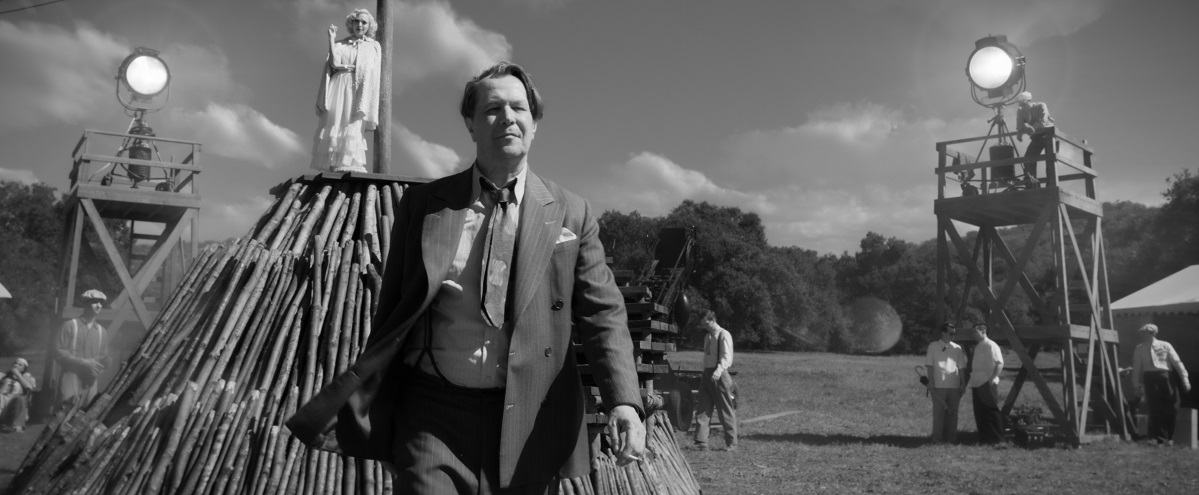Movie Info
Movie Info
- Director
- David Fincher
- Run Time
- 2 hours and 11 minutes
- Rating
- R
VP Content Ratings
- Violence
- 1/10
- Language
- 2/10
- Sex & Nudity
- 1/10
- Star Rating
Relevant Quotes
Wine is a mocker, strong drink a brawler, and whoever is led astray by it is not wise.
For what will it profit them to gain the whole world and forfeit their life?

I love films about filmmaking, and David Fincher’s Mank, centering on Herman J. Mankiewicz the co-writer of Citizen Kane, is no exception. Based on a script by Jack Fincher, the director’s late father, the film has scintillating dialogue that is as delightful to the ear as the repartee in the madcap comedies popular during the period of the story, the mid 30s to 1940. And Erik Messerschmidt’s crisp B&W photography certainly evokes that bygone era. The typed-out scene settings that introduce each sequence gives the film a writerly or journalistic tone
In 1940 Mankiewicz, or Mank as this German immigrant preferred to be called, had been the highest paid screenwriter in Hollywood, so well known for writing clever quips that he is often called in to doctor an ailing script. But his alcoholism has caught up with him, so many consider him a has-been, The son of Jewish German immigrants, he had started out as a journalist, became a film critic in NYC and contributor to major magazines, collaborated with other major writers on a Broadway review, and was a member of the literary group known as the Algonquin Round Table. Lured to Hollywood by Paramount producer Walter Wanger, he quickly achieved success with his witty phrases, rising to be the head of the studio’s scenario department by the end of 1927. He drew many other writers to Hollywood, as this film shows. But he also became an alcoholic, which coupled with his cynical disdain for Hollywood, greatly impedes his career.
In our story he has been hired by Orson Welles (Tom Burke) to write the first draft of a film tentatively titled American. Dubbed “the boy genius” because of his huge success in radio and the theater, the 24-year-old Welles had suggested two other projects, which Paramount had turned down. Welles had a fuzzy idea of a story about the rise and fall of a magnate but needed a veteran writer to bring it alive. He dispatches his right-hand man, producer John Houseman (Sam Troughton), to supervise closely the writer, bunking them in a remote ranch house near Victorville to keep him away from the booze which dominates his life. Mank is told at one point, “Write what you know,” and what he knows is the career and personal life of newspaper mogul William Randolph Hearst (Charles Dance).
Still on crutches after a car wreck, the remote location was both to remove distractions and to keep alcohol from the writer. Of course, Mank is able to sneak in a cache. Welles keeps in touch by phone and an occasional visit, taking a scene or two of the script and working on it himself and then sending it back. We see nothing of Welles’s working on the script or interacting with others. The Boy Wonder is definitely just a supporting character in this telling of the story of how Citizen Kane came to be.
The film jumps back and forth between 1940 and Mank’s past experience with the studio heads and Hearst during the 30s. He had drawn his writer friend Charlie Lederer (Joseph Cross) to Hollywood with the telegram “Millions are to be grabbed out here and your only competition is idiots”). Charlie is the nephew of Hearst’s mistress, the actress Marion Davies (Amanda Seyfried). So, it is through him that Mank first meets Hearst on an outdoor movie set at San Simeon where Marion is tied to a stake atop a tall pile of kindle wood. This is evidently a scene from one of the costume dramas that Hearst had forced his mistress to star in as a part of his campaign to lift her above the genre for which she was truly fit for, comedy.
During their brief interchange the tycoon is amused byt the writer’s quick wit, the result being that not only does he invite him to his round of parties at his mammoth San Simeon estate (“half the size of Connecticut”) but insists that he be seated close to him so he can enjoy his repartee. During the course of an evening, Mank manages to insult about everyone. Also, he draws close to Marion, discovering that she is far more than the gold digger everyone assumes her to be.
A moving subplot, probably introduced to display the writer’s humane side, involves Mank’s relationship at the ranch house to his British typist Rita Alexander (Lily Collins) whose husband is one of the R.A.F. pilots defending her country against the Nazis. She disapproves of his deceptive plan to obtain alcoholic drinks but keeps mum about it. Her disdain for her boss changes when she learns from another employee how Mank has saved the lives of dozens of German anti-Nazis by sponsoring their emigration to America. Mank takes more of an interest (non-romantic) in her when she receives a notification that her husband is M.I.A.
The successful struggle to finish the script on time pales when William Randolph Hearst learns that he and Marion are the basis for the characters in the film. Several figures, including his younger brother Joseph (Tom Pelphrey), warn Mank and Welles of the consequences, but they press ahead, bucking at first their own studio and then the combined forces of the other studio execs, offering, under pressure from Hearst, to buy the film so that they can burn it.
Another dimension of the power of Hearst and the movie studio is played out in a flashback to the 1934 California governor’s race in which the famous muckraking writer Upton Sinclair (Bill Nye) is running as a Socialist. His program to improve the lot of the commoner is strongly disapproved by Hearst, who has abandoned his earlier populist principles, as well as by the studio heads—Hollywood as a whole was much more conservative back then. One of the movie’s many good lines comes when Mank argues with MGM production chief Irving Thalberg (Ferdinand Kingsley), “ Irving, you are a literate man. You know the difference between communism and socialism. In socialism, everyone shares the wealth. In communism, everyone shares the poverty.”
Mank is upset when he learns that an ambitious second string director*, in exchange for an opportunity to direct a feature film, has been engaged by MGM to direct propagandist fake interviews attacking Sinclair. These phony interviews with supposedly typical voters slandering Sinclair are shown in theaters as genuine news reports, turning the tide of public opinion against Sinclair. This was at a time when all theaters ran “News of the Day” stories so that the average person obtained almost as much of their news at theaters as from their newspapers and radios at home. Mank is disgusted with this misuse of the power of the medium and saddened at what happens to the would-be director after the latter has confessed his guilt to him.
At well over two hours David Fincher’s film is far more detailed and complex than the 1999 film RKO 281. Less than an hour and a half, the earlier film is a much more fictional account (see the review below) centering on Welles, and thus weighing in on the controversy over authorship of the film more on the side of the director. In the Fincher film we learn that in the original contract with Welles the writer has given up his credit rights, but as he struggled to write and came up with such memorable dialogue, his pride of authorship inspired him to demand recognition as the co-author. The new film also shows us more of its historical context by including the 1934 governor’s race and how the rich and powerful used fake news and film to influence the public to vote against its own interest. The prevailing anti-Semitism among the populace is also a factor.
Those who love old films will enjoy the screen full of cameos of stars and studio executives. Watch for brief appearances of actors portraying Charlie Chaplin, Eddie Cantor, Norma Shearer, Joan Crawford, Geraldine Fitzgerald; costume designer Edith Head; writers Ben Hecht, George S. Kaufman, Charles MacArthur, Sid Perelman; and studio CEOs George Shaefer RKO), Louis B. Mayer (Arliss Howard), David O. Selznick (producer of Gone With the Wind), Irving Thalberg, and Darryl F. Zanuck (Twentieth Century Fox).
Given all the powerful figures depicted, the film can be seen as a study of power and persistence, a David vs. Goliath story. Hearst and the studio heads have far greater financial and social power than Orson Welles and Herman Mankiewicz, but the latter two have great talent and a determination not to cave in to pressure, no matter where it came from. Both his brother Joseph and Marion Davies visit Mank in a vain attempt to talk him out of going on with the film. Marion is especially distressed because the mistress of the film’s newspaper mogul is depicted as a whining no-talent alcoholic, a far cry from the reality. Mank tries to claim that his character is not based on Marion, as will Welles.
There is a costume party scene at San Simeon at which a drunken Mank talks about a movie proposal built around Don Quixote and during the telling insults everybody so scathingly that, one by one, most of the costumed guests stalk out of the room. Very much over the top (you can read this tirade at the IMDB site for Mank in the “Quotes” section—click here. Well over a page long, it’s the longest quotation I have seen from a movie!), it is hard to believe that Hearst would have put up with the rant, but he does. And then he tells the Parable of the Monkey and the Organ Grinder about illusion and reality.
The parable takes on meaning when we consider the aftermath. Who really is in control of things? Citizen Kane is finished and released despite a news blackout by all the Hearst newspapers that blanket the country and the refusal of all the studio-connected movie theaters to show it. The premiere is well attended, the critics mostly reviewing the film positively. However, the public stays away. Word that the story is a downer and the plot confusing, probably kept a public beset by so much bad news from buying a ticket. The film would languish in obscurity until it was rediscovered and re-evaluated in the Fifties. What happens to Welles and his once-promising career you probably know. If not, check it out on the Internet—but by all means, watch this marvelously interesting film.
*This character, given the name Shelly Metcalf (Jamie McShane), is a fictional one used as a plot device to move Mank toward deciding to fully commit to writing the screenplay attacking Hearst. The fake interviews, however, were real, and were effective in turning the public against Sinclair. The studio hack who directed the interviews never repented of his dishonesty.
For detailed information on the writing of the script see the Wikipedia article at https://en.wikipedia.org/wiki/Screenplay_for_Citizen_Kane
This review will be in the January issue of VP along with a set of questions for reflection and/or discussion. If you have found reviews on this site helpful, please consider purchasing a subscription or individual issue in The Store.

